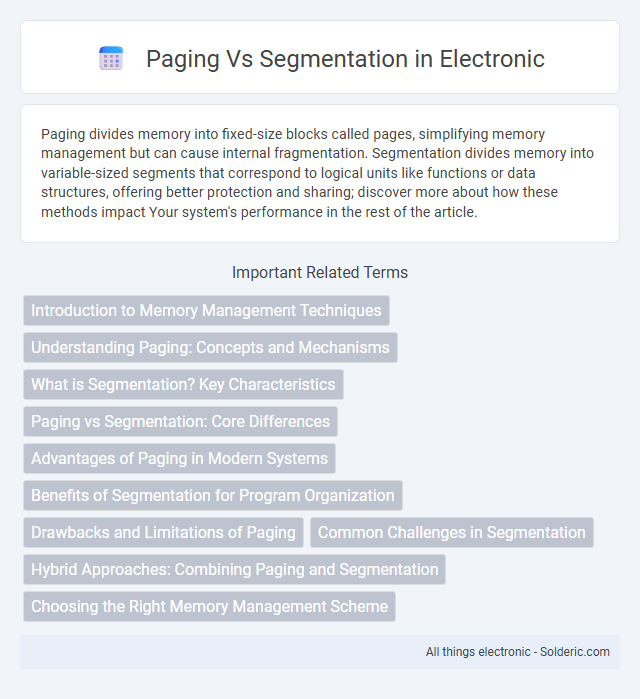Paging divides memory into fixed-size blocks called pages, simplifying memory management but can cause internal fragmentation. Segmentation divides memory into variable-sized segments that correspond to logical units like functions or data structures, offering better protection and sharing; discover more about how these methods impact Your system's performance in the rest of the article.
Comparison Table
| Feature | Paging | Segmentation |
|---|---|---|
| Memory Division | Fixed-size pages | Variable-size segments |
| Address Structure | Page number + offset | Segment number + offset |
| Fragmentation | Internal fragmentation | External fragmentation |
| Memory Management | Simpler, easy to implement | Complex, requires segment table |
| Protection | Limited (same for all pages) | Fine-grained per segment |
| Efficiency | Better for fixed-size blocks | Better for logical grouping of data |
| Usage | Widely used in modern OS | Used for logical program structures |
Introduction to Memory Management Techniques
Paging divides memory into fixed-size blocks called pages, enabling efficient allocation and reducing fragmentation by mapping pages to physical frames. Segmentation organizes memory into variable-sized segments based on logical divisions like code, data, and stack, supporting easier sharing and protection. Your understanding of these techniques helps optimize memory usage and system performance in operating systems.
Understanding Paging: Concepts and Mechanisms
Paging divides memory into fixed-size blocks called pages, enabling efficient and flexible allocation without external fragmentation. Each page maps to a frame in physical memory through a page table, allowing your system to translate logical addresses to physical addresses seamlessly. This mechanism supports virtual memory implementation by enabling pages to be loaded and swapped dynamically, optimizing RAM usage.
What is Segmentation? Key Characteristics
Segmentation is a memory management scheme that divides the process's memory into variable-sized segments based on logical units such as functions, data structures, or modules, enhancing program modularity and protection. Key characteristics of segmentation include logical division of memory, each segment having a base and limit, and supporting easier sharing and protection by isolating segments. Unlike paging, segments vary in size and provide meaningful boundaries aligned with the program's structure, enabling more efficient memory use and error detection.
Paging vs Segmentation: Core Differences
Paging divides memory into fixed-size blocks called pages, enabling efficient and simple memory management without external fragmentation. Segmentation organizes memory into variable-sized segments based on logical divisions like functions or data structures, which provides protection and sharing but may cause external fragmentation. Your choice between paging and segmentation depends on whether you prioritize straightforward allocation with paging or logical organization with segmentation.
Advantages of Paging in Modern Systems
Paging in modern systems simplifies memory management by dividing physical memory into fixed-size frames, enabling efficient allocation and reducing fragmentation. It enhances system performance through faster address translation using page tables and supports virtual memory implementation, allowing programs to use more memory than physically available. Moreover, paging improves multitasking by isolating process memory spaces, increasing security and stability in operating environments.
Benefits of Segmentation for Program Organization
Segmentation enhances program organization by dividing a program into logical units such as functions, data structures, and modules, making the code more manageable and easier to understand. This logical division supports better protection and sharing, as different segments can have distinct access rights and be shared among processes without exposing the entire program. Moreover, segmentation facilitates dynamic memory allocation and efficient use of address space, reducing fragmentation compared to purely paging systems.
Drawbacks and Limitations of Paging
Paging suffers from internal fragmentation due to fixed-size pages, which can lead to inefficient memory utilization when processes have varying memory requirements. The use of page tables increases memory overhead and can slow down address translation, especially in systems without a Translation Lookaside Buffer (TLB). Additionally, paging does not support the logical division of processes, making it less flexible for handling variable-sized memory segments such as code, data, and stack.
Common Challenges in Segmentation
Segmentation faces common challenges such as external fragmentation, which wastes memory by leaving small unused gaps between segments, and the complexity of handling variable segment sizes that complicate memory allocation and management. Unlike paging, segmentation requires maintaining a segment table with base and limit registers for each segment, increasing overhead and potential for segmentation faults when accessing invalid segments. Your system must carefully manage these issues to ensure efficient memory use and prevent access violations.
Hybrid Approaches: Combining Paging and Segmentation
Hybrid approaches combining paging and segmentation leverage the benefits of both techniques by dividing memory into segments that are further split into fixed-size pages. This method enhances memory management efficiency and flexibility, allowing your system to handle varying-sized data structures with reduced fragmentation. By integrating segmentation's logical division with paging's physical allocation, hybrid models optimize resource utilization and improve overall system performance.
Choosing the Right Memory Management Scheme
Choosing the right memory management scheme depends on your system's requirements for efficiency and flexibility. Paging offers fixed-size blocks making it simple to manage memory and avoid fragmentation, ideal for systems prioritizing consistent memory access times. Segmentation provides variable-sized blocks aligned with logical program units, benefiting applications requiring dynamic and logical division of memory for more intuitive data handling.
Paging vs Segmentation Infographic

 solderic.com
solderic.com